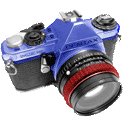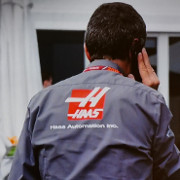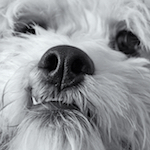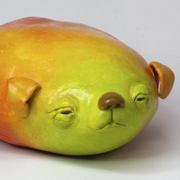|
I'm not the person to ask about Canon, so I don't know how old that 20D might be. In any case, glad to hear you went and... touched... some cameras. Don't worry about the UV filter, they don't usually cost enough to worry about either way, just take it off and put it in a box. Making a decision now comes down to how you, personally, feel about the money. Enjoy!
|
|
|
|

|
| # ? May 13, 2024 23:05 |
|
Tenacious J posted:Great, thanks for the nice information. I was just at the store checking them out and I have to say, the Canon was by far the best feeling. Local used I am seeing a 20D + kit lens for $200, or a Rebel XTi with a 70-300mm for $400 (except it has a UV filter). However as you mentioned it's probably worth it to get the Ti3 - it has a 90 day return policy as well so there ya go! While it may be harder to find, another option would be a pentax k-30 or k-50 kit. One of the kits includes the DA 55-300 which will be a nice addition for birding.
|
|
|
|
I'm sticking with Costco for the return policy just in case and unfortunately there's no Pentax. Anyway, thanks for the help, I've actually decided to go with the Sony a58 and save up for a proper zoom lens. I'll keep an eye out for a beercan.
|
|
|
|
Tenacious J posted:I'm sticking with Costco for the return policy just in case and unfortunately there's no Pentax. Anyway, thanks for the help, I've actually decided to go with the Sony a58 and save up for a proper zoom lens. I'll keep an eye out for a beercan. Best Buy is also good for their return policy. Enjoy the new camera 
|
|
|
|
I'll just put this out there- if birds are your primary subject, you might check out something like the Canon SX50. There are downsides to a bridge camera compared to a DSLR (sensor size, af speed, instant response for the shutter button, ability to upgrade lenses, etc), but it's hard to beat that reach at that price, plus it's small enough you'll actually take it everywhere. A couple of people in the A/T bird thread were recommending the SX50. I went from a bridge to a DSLR about 3 years ago, and I'm half-way considering getting something like an SX50 as an additional camera since super-telephoto lenses for DSLRs are so feakin' heavy and expensive.
|
|
|
|
ExecuDork posted:The most important feature, bar none, of any camera is that you WANT TO HOLD IT IN YOUR HANDS. By all means, if you get the chance to handle a camera before buying it, do so, and if it just feels "off" compared to others you've picked up, then trust your gut and move on. But there's no Ollivanders: Makers of Fine
|
|
|
|
Fair point, I like to overemphasize the ergonomics point because so often I see people (not so much here, but other places on the web, especially Facebook) getting obsessive about long lists of features and counting megapickles and spinning irrelevant anecdotes about their uncle's opinion about some bridge camera from 8 years ago. It's completely subjective, and you are quite correct that there are teams of talented designers working to make sure the cameras they help to make are objects people actually want to buy. It's pretty hard to buy a bad camera anymore, I think. I think there's a beercan for sale in the Buy/Sell thread. EDIT: I don't know if it got through by hint and subtlety (probably it did), but Sony bought Minolta's camera business in the early 2000's, so the Sony Alpha mount is the same as Minolta's Autofocus mount from the 90's. Check locally for Minolta Maxxum cameras for sale (Craigslist, Kijiji, Gumtree, garage sales, whatever). Film is fun and there are some decent (mostly not "great", but "decent") lenses that can be picked up for effectively pocket change. The beercan is the most prominent example, but there are solid staples like Nifty Fifties (50mm f/1.7) and 28/2.8 (28mm f/2.8) floating around that will be quite nice on a modern DSLR. ExecuDork fucked around with this message at 22:02 on Aug 27, 2013 |
|
|
|
I think even 300mm is short for birds but I guess it depends on how actively you want to stalk them. I would prefer to keep my rear end in my seat. 3D tracking AF is nice to have for birds.
|
|
|
|
I use a 400mm lens on a 2x crop factor sensor and I still find myself wanting a longer lens sometimes. Otoh this setup is long enough that you get to the point that birds like robins will fly too close to you to focus on 
|
|
|
|
I have a 300mm and it works ok but you have to crop everything. The proportional gain of going from 300 to 400 is not that much bigger than going from 250 to 300.
|
|
|
|
mclifford82 posted:Best Buy is also good for their return policy. Enjoy the new camera As an FYI Best buy changed their return policy from 30 days to 15 days (Reward Zone Silver is still 60 days I believe)
|
|
|
|
BetterLekNextTime posted:I went from a bridge to a DSLR about 3 years ago, and I'm half-way considering getting something like an SX50 as an additional camera since super-telephoto lenses for DSLRs are so feakin' heavy and expensive. Depends on what you consider heavy and expensive. The Canon 400mm f/5.6L is surprisingly light and not horribly expensive. You can get it used for 900 or so if you are patient.
|
|
|
|
My 400/5.6 cost me $40 on ebay.
|
|
|
|
I'm still waiting for somebody to get drunk and pick up one of those ridiculous 650mm f/8 el-cheapo superteles (usually advertised as 650-1300mm because they come with a crappy 2x teleconverter) and shoot stalker pics of their neighbour's cat making GBS threads in the rosebushes. It's gonna be me, I can tell. I'm going get to drunken eBaying one day, and it's going to be ugly.
|
|
|
|
ExecuDork posted:I'm still waiting for somebody to get drunk and pick up one of those ridiculous 650mm f/8 el-cheapo superteles (usually advertised as 650-1300mm because they come with a crappy 2x teleconverter) and shoot stalker pics of their neighbour's cat making GBS threads in the rosebushes. KEH has them for cheaper than the Ebay. Tell your drunkself to at least buy the cheapest one you can.
|
|
|
|
I'd like to a shoot a few videos with my Canon EOS 600D, but I've seen a few random people online saying that using a DSLR for lots of video (e.g. over an hour at a time) can be damaging to the sensors. Are these just internet crazies or is that something genuine?
|
|
|
|
Tenacious J posted:I'm sticking with Costco for the return policy just in case and unfortunately there's no Pentax. Anyway, thanks for the help, I've actually decided to go with the Sony a58 and save up for a proper zoom lens. I'll keep an eye out for a beercan. I've got a beercan in the buy/sell thread!
|
|
|
|
ExecuDork posted:Fair point, I like to overemphasize the ergonomics point because so often I see people (not so much here, but other places on the web, especially Facebook) getting obsessive about long lists of features and counting megapickles and spinning irrelevant anecdotes about their uncle's opinion about some bridge camera from 8 years ago. ExecuDork posted:It's pretty hard to buy a bad camera anymore, I think.
|
|
|
|
ExecuDork posted:
Friends don't let friends buy Sigmas.
|
|
|
|
The SD1 Merril isn't a bad camera either to be honest. Probalby overpriced for what it is, but leaps and bounds better than the older options
|
|
|
|
Question Mark Mound posted:I'd like to a shoot a few videos with my Canon EOS 600D, but I've seen a few random people online saying that using a DSLR for lots of video (e.g. over an hour at a time) can be damaging to the sensors. Are these just internet crazies or is that something genuine? I remember reading something about this in a manual for Canon. You can read more about it, but as I understand it the camera have a protection against overheating. I assume that the damage they are talking about would be caused by heat or overheating. This is quoted from the manual. quote:
erephus fucked around with this message at 20:27 on Aug 28, 2013 |
|
|
|
Musket posted:KEH has them for cheaper than the Ebay. Tell your drunkself to at least buy the cheapest one you can. I've already got a date lined up for me, a bottle (or two), and KEH.com. The theme was going to be "The Merlot of Minolta", but knowing *that* I might need to come up with other options (and restraint. Definitely need to find some restraint. Self-control and Discipline have agreed to not be around that night, so I'll have to look around for something else). ***** I downloaded the K-5 owner's manual (because I just bought one
|
|
|
|
erephus posted:I remember reading something about this in a manual for Canon. You can read more about it, but as I understand it the camera have a protection against overheating. I assume that the damage they are talking about would be caused by heat or overheating. 
|
|
|
|
ExecuDork posted:I've already got a date lined up for me, a bottle (or two), and KEH.com. The theme was going to be "The Merlot of Minolta", but knowing *that* I might need to come up with other options (and restraint. Definitely need to find some restraint. Self-control and Discipline have agreed to not be around that night, so I'll have to look around for something else). I got drunk one night and ordered a ME super. Got drunk like 2 weeks later again and another ME super showed up at the door a few days later. Got drunk early this month and a box full of poo poo showed up at my door including a P67, a shitload of film and some horribly crappy 35mm plastic rangefinder. The moral of the story is "buy poo poo when you're drunk, then you get lots of surprise presents for yourself". Edit: poo poo, I forgot about the night I got drunk and bought Reich's Nikonos, and I ended up getting a box with that, a pic of his junk, and a jar of lube. Best box ever. 
|
|
|
|
I recently got a K30. I have ordered the book "Understanding Exposure" and I assume it will cover some of this but I keep seeing suggestions to shoot manual and I have no idea where to start. I understand aperture is the size of the light opening with higher numbers being smaller openings and with deep depth of field and lower numbers being big openings with shallow depth of field. f8 is supposed to be a good general purpose fstop? Shutter speed is fairly strightforward - measured in seconds or fractions of a second, faster speeds freeze action and slower speeds blur motion. ISO is sensitivity with low numbers taking longer to expose but giving more detail and high numbers faster to expose but renders less detail. So the balance of these three things gives an exposure and I can see how using them in concert can give various effects. I have no idea where to start calculations from, however. I assume you want to use ISO 100 unless you can't, and it looks like f8 is a standard fstop, what is a starting point for shutter speed though and how do I correctly decide what to use? Even in manual mode there is a button that suggests values to use and a light meter thing that gives -5 through +5 with settings adjustments making this closer or further from zero which is supposed to be what the camera things is a good exposure. Everything I am reading is explaining fstops, shutter speed, and ISO - but I am not sure where to start the process of manually calculating an exposure solution. Does that book explain this?
|
|
|
|
Check the light meter on the bottom of your display. If it's in the middle then you're getting a "correct exposure" with your current settings. The idea is to decide what setting you want to lock down based on your subject matter (shooting a portrait - low aperture, shooting motion - high shutter) and then adjust the other settings until you've got a correct exposure.
|
|
|
|
That is precisely the point of the book. For now I'd say don't worry about exposure/aperture/iso and focus on going through the camera manual and look at the other features -- how to change white balance, how to actually adjust ISO when you need to, how to change back to default settings etc. That said, for just about all 'walking around and shooting situations' I think most people put it in Aperture or Shutter priority (might be Tv and Av on your camera, dunno). This lets you select one of aperture or shutter speed to pin down, and lets the camera figure out the other one so you don't have to do the calculations in your head. Most of my shooting is aperture priority, with shutter priority occasionally useful when I'm in a less-than-bright room and need all the help I can get.
|
|
|
|
I have been shooting in manual for the last year to get a feel for the controls and a better Idea what settings are going to be needed in a situation. Thank being said I just ventured in AV & TV and it's great. I can dial AV for nice background when the kids are still, then bang it over to TV if they are running around a bunch. I missed a lot less good photos that day. I still recommend getting very familiar with manual though.
|
|
|
|
A whole year on manual just to get used to the controls? 
|
|
|
|
Casu Marzu posted:Edit: poo poo, I forgot about the night I got drunk and bought Reich's Nikonos, and I ended up getting a box with that, a pic of his junk, and a jar of lube. Best box ever.  that's awesome, I need to remember that. The last time I sold something on ebay I added an extra lens that I wanted to get rid of (it was 20 years old), clearly I'm doing this wrong. that's awesome, I need to remember that. The last time I sold something on ebay I added an extra lens that I wanted to get rid of (it was 20 years old), clearly I'm doing this wrong.
|
|
|
|
Redleg posted:I recently got a K30. I have ordered the book "Understanding Exposure" and I assume it will cover some of this but I keep seeing suggestions to shoot manual and I have no idea where to start. It depends on the look of the picture you want and where the creativity begins with photography. Do you want to isolate your subject from the background? Then start with the aperture (or go into aperture priority Av mode). Do you want to get a frozen frame of a moving subject? Then start with the shutter speed (or go into shutter priority Tv mode). Once you have that sort of information you can choose an ISO setting that will meet your needs. The usual formula is 1 over the focal length of the lens to get a shutter speed that you can hand hold. Since you camera has in body stabilization, you may be able to go below that a couple of stops.
|
|
|
|
Eegah posted:That is precisely the point of the book. For now I'd say don't worry about exposure/aperture/iso and focus on going through the camera manual and look at the other features -- how to change white balance, how to actually adjust ISO when you need to, how to change back to default settings etc. So does that mean the only setting you ever really fiddle with is aperture? As in, set the zoom, set the aperture, take the picture - is that common? I just got my camera but assumed there were many different settings that you needed to balance at all times for the best picture, I didn't think it was so simple - am I missing something?
|
|
|
|
Tenacious J posted:So does that mean the only setting you ever really fiddle with is aperture? As in, set the zoom, set the aperture, take the picture - is that common? I just got my camera but assumed there were many different settings that you needed to balance at all times for the best picture, I didn't think it was so simple - am I missing something? I'm still extremely novice at this, so take this with that in mind, but I would say it really depends on what you're doing. When I'm photographing an event (usually just a family gathering of some sort), I'll stick on aperture priority and modify the ISO setting (generally between 100 and 400, but sometimes use auto to get some in-between or if I'm unsure). But sometimes I notice that my camera in particular has trouble getting a good enough exposure while indoors on aperture priority, so I switch over to shutter priority instead, sacrificing some of the DoF benefits. But even then there's the time where you're photographing a landscape or stars (or something with that kind of configuration), a full manual setting might be the only way to get exactly what you want (DoF, exposure time, etc.).
|
|
|
|
Tenacious J posted:So does that mean the only setting you ever really fiddle with is aperture? As in, set the zoom, set the aperture, take the picture - is that common? I just got my camera but assumed there were many different settings that you needed to balance at all times for the best picture, I didn't think it was so simple - am I missing something? The three points of the exposure triangle are your ISO, your aperture, and your shutter speed. I usually set my ISO at 100 (lowest I have on my camera, to keep noise to the bare minimum--if I need faster shutter speeds, I'll bump the ISO up), set the aperture that I want based upon the depth of field I want, and let the camera spit out the appropriate shutter speed for an "ideal" exposure according to the camera's light meter. The only difference between aperture priority and manual would be I'd just have to set the shutter speed as well, and read off of the camera's light meter to see what my exposure would be. Understanding Exposure really is a good book for learning what the three variables do, and when you'd want to change them.
|
|
|
|
Tenacious J posted:So does that mean the only setting you ever really fiddle with is aperture? As in, set the zoom, set the aperture, take the picture - is that common? I just got my camera but assumed there were many different settings that you needed to balance at all times for the best picture, I didn't think it was so simple - am I missing something? Well it definitely depends on what and where you're shooting, but I generally let the camera set most if not all aspects. For example, I shoot at the dog park a lot, watching my dog chase and wrassle. Them fuckers move fast and I don't have time to fiddle with settings. I know from experience I generally need 1/1000 to eliminate blur when they're moving around a lot. I set aperture to minimum to get the most light (f/4 to f/5.6 on my long zoom lens), and set the auto-ISO (a relatively complicated feature on Nikons but pretty cool once you get used to it, if cumbersome to set up) to raise the ISO to whatever it needs so ensure my shutter speed is 1/1000. The rest of my time there I let the camera do the rest.  (~200mm, f/5.6 for 1/1000s, ISO 140) I generally shoot Aperture Priority when I'm at the dog park because I want to be able to control the depth of field. There's no difference going from 1/1000 to 1/2000 if motion is frozen anyway, but changing the aperture will change what's in focus and what isn't. Last weekend I was at the Pacific Pinball Museum in Alameda. I knew going in that it wasn't going to be the most well-lit area and would need all the help I could get, and that zooming in wouldn't be an issue. I took my fastest lens -- the 35mm f/1.8 -- set it on Shutter Priority for 1/60s (slowest I thought I could get away with hand-held), cranked the ISO to a constant 3200 and let the camera set the aperture the whole time.  (35mm, f/2.5 for 1/60s, ISO 3200) Most photos wound up being f/1.8 here, tho with a few tables in a better-lit hallway I got a bit more. Really needed Nik's noise reduction software in post to clean these up though, 3200ISO was rather pushing it. If I were a ~serious~ photographer doing studio shots or other things already set up I'd be a good bit more conscious about the settings but most the time? Nah, just know how aperture/shutter/ISO interact, think generally about what and where you're shooting, set as much as you can and enjoy pressing the button.
|
|
|
|
Shellman posted:Understanding Exposure really is a good book for learning what the three variables do, and when you'd want to change them. The book will also tell you what to meter off of to get a proper exposure. Much of the time, you'll want to set exposure from the sky instead of what you're actually photographing. That part isn't a terribly large part of the book, but for pretty much every picture featured, he'll say how he exposed for it, which usually includes how he metered it.
|
|
|
|
Is there some kind of good guide for dummies on using the Auto-ISO on Nikon? I've been doing manual ISO on Aperture priority, and then manually adjusting the ISO until the meter gives me an exposure time I'll be happy with.
|
|
|
|
404notfound posted:The book will also tell you what to meter off of to get a proper exposure. Much of the time, you'll want to set exposure from the sky instead of what you're actually photographing. That part isn't a terribly large part of the book, but for pretty much every picture featured, he'll say how he exposed for it, which usually includes how he metered it. I need to go back and re-read that part again. I can never keep Mister Blue Sky Brother Bear straight from Mister Greenpeace Genes or whatever. He has too many magical metering sky friends.
|
|
|
|
FISHMANPET posted:Is there some kind of good guide for dummies on using the Auto-ISO on Nikon?
|
|
|
|

|
| # ? May 13, 2024 23:05 |
|
Tenacious J posted:So does that mean the only setting you ever really fiddle with is aperture? As in, set the zoom, set the aperture, take the picture - is that common? I just got my camera but assumed there were many different settings that you needed to balance at all times for the best picture, I didn't think it was so simple - am I missing something? It really is quite simple - I pretty much never "calculate" anything. Most of my shooting is in Av (aperture priority), with ISO set to something reasonable; I like 200. I'll set the aperture, often f/8 because my kit zoom lens is terribly soft any wider than that, then just shoot. I'll watch my shutter speeds, and if I think they're getting too slow (or, rarely, too fast - there's no point in shooting at 1/4000 outside of a few rare situations) I'll adjust the ISO upwards. When I switch lenses I'll set a different aperture, for example I have a 28mm f/2.8 that's quite sharp at f/4, and when shooting with my 105mm f/2.5 macro I tend to fiddle with the aperture for each shot. You should be able to set up the control wheel(s) for your camera, the default setting (e.g. rear or only wheel adjusts aperture when in Av mode) is usually good but I set the front wheel on my K10D to adjust ISO when in Av (the default was nothing). This way I can quickly move up my ISO when (for example) I move from shooting up at something (like a bird in a tree, very bright background) to down at something (like a bug on a flower, darker background) and keep my shutter speed up without needing to open up the aperture - this might be specific to my holy-crap-that's-soft kit zoom, but the principle is still useful I think. My shooting order-of-operations is typically Compose, adjust zoom (or zoom ŕ pied), double-check aperture and ISO, check shutter speed, adjust if necessary, re-compose (small movements, I like to try to avoid cutting off feet or I'll move a little to cut down on flare), shoot. Then, because I'm a hopeless spray-and-pray fool, shootshootshootshootshootshootshootshoot heywheredidthebirdgo??
|
|
|
























